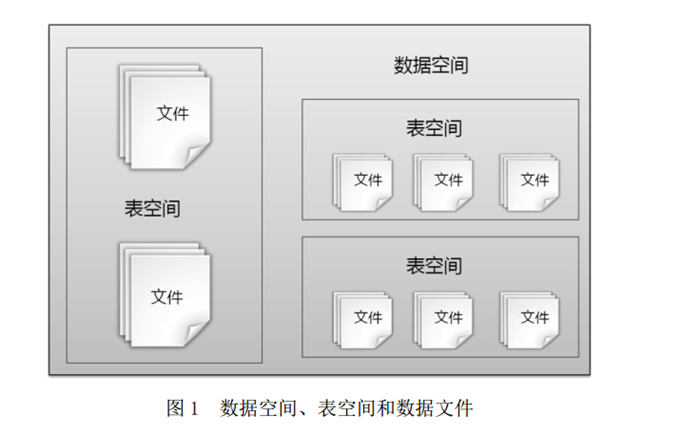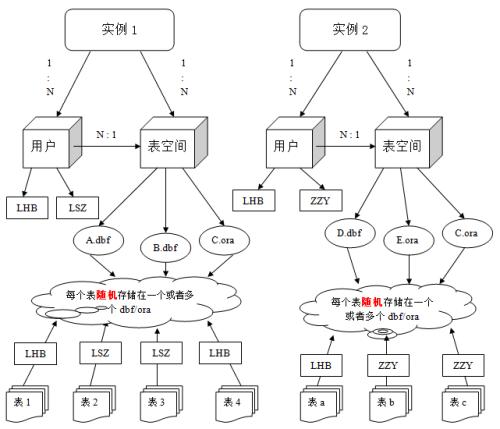完整的Oracle数据库通常由两部分组成:Oracle数据库和数据库实例。
- 数据库是一系列物理文件的集合(数据文件,控制文件,联机日志,参数文件等);
- Oracle数据库实例则是一组Oracle后台进程/线程以及在服务器分配的共享内存区。
在启动Oracle数据库服务器时,实际上是在服务器的内存中创建一个Oracle实例(即在服务器内存中分配共享内存并创建相关的后台内存),然后由这个Oracle数据库实例来访问和控制磁盘中的数据文件。Oracle有一个很大的内存快,成为全局区(SGA)。
数据库
数据库是数据集合。Oracle是一种数据库管理系统,是一种关系型的数据库管理系统。
通常情况了我们称的“数据库”,并不仅指物理的数据集合,他包含物理数据、数据库管理系统。也即物理数据、内存、操作系统进程的组合体。
select name from v$database;
数据库实例
实例是访问Oracle数据库所需的一部分计算机内存和辅助处理后台进程,是由进程和这些进程所使用的内存(SGA)所构成一个集合。其实就是用来访问和使用数据库的一块进程,它只存在于内存中。我们访问Oracle就是访问一个实例
- 实例名指的是用于响应某个数据库操作的数据库管理系统的名称。她同时也叫SID。实例名是由参数instance_name决定的。
- 一个数据库可以有多个实例,在作数据库服务集群的时候可以用到
select instance_name from v$instance;
-- jdbc:oracle:thin:@localhost:1521:orcl(orcl就为数据库实例名)
表空间

Oracle数据库是通过表空间来存储物理表的,一个数据库实例可以有N个表空间,一个表空间下可以有N张表。
- 有了数据库,就可以创建表空间。
- 表空间(tablespace)是数据库的逻辑划分,每个数据库至少有一个表空间(称作SYSTEM表空间)。
- 为了便于管理和提高运行效率,可以使用一些附加表空间来划分用户和应用程序。(例如:USER表空间供一般用户使用,RBS表空间供回滚段使用。)
- 一个表空间只能属于一个数据库。

-- 创建表空间语法
create tablespace db_test -- 表空间名称
datafile 'D:oracleproduct10.2.0userdatadb_test.dbf' -- 表空间数据文件路径
size 50m -- 表空间初始大小
autoextend on;
-- 查看已经创建好的表空间:
select default_tablespace, temporary_tablespace, d.username
from dba_users d
用户
Oracle数据库建好后,要想在数据库里建表,必须先为数据库建立用户,并为用户指定表空间。
-- 创建新用户
CREATE USER utest -- 用户名
IDENTIFIED BY utestpwd -- 密码
DEFAULT TABLESPACE db_test -- 表空间(默认USERS)
TEMPORARY TABLESPACE temp; -- 临时表空间(默认TEMP)
-- 分配权限
GRANT CONNECT TO utest;
GRANT RESOURCE TO utest;
GRANT dba TO utest; -- dba为最高级权限,可以创建数据库,表等。
-- 查看数据库用户
select * from dba_users;
有些时候查询表数据需要在表前加上用户名(表空间对应用户的原因)
SQL查询01
select userenv('language') from dual;--AMERICAN_AMERICA.ZHS16GBK 环境变量(列名中文别名显示)
select * from V$NLS_PARAMETERS--AMERICAN
-- 解锁 scott 用户并重新设置密码
alter user scott account unlock;
alter user scott identified by tiger;
-- =====基本查询
--1.查询出所有emp中的信息,并用中文进行字段重命名 就别名用双引号
select empno as "员工编号",ename "员工姓名",job 职位,mgr "领导编号",hiredate "入职日期",sal "工资",comm "奖金",deptno "部门编号" from emp;
--2.查询emp表中员工的job信息,并去除重复信息
select distinct(job) from emp;
--3.查询emp表中员工的全年的工资总和(sal总和)
select ename,12*sal from emp;
--4.查询emp表中员工的全年收入总和(sal+comm的总和) nvl表示判断空值,为空用0替代
select ename,12*sal+nvl(comm,0) from emp;
--5.查询emp表中员工编号,姓名
--输出格式如下:编号:xxx,姓名:xxx
----Concat拼接方式
select concat(concat('编号:',empno),concat(',姓名:',ename)) from emp;
----Oracle的||方式 相当于我们熟悉的加号
select '编号'||empno||',姓名:'||ename from emp;
--=============================================条件查询
--1.查询工资大于1500的员工
select * from emp where sal >= 1500;
--2.查询工资大于1500并且有奖金的雇员
select * from emp where sal >= 1500 and comm is not null;
--3.查询工资大于1500或者有奖金的雇员
select * from emp where sal >= 1500 or comm is not null;
--4.查询工资大于1500并且没有奖金的雇员
select * from emp where sal >= 1500 and comm is null;
--5.查询员工姓名为smith的员工
select * from emp where ename = 'SMITH';
--=============================================范围查询
--1.查询工资大于1500但小于3000的全部雇员
---->=,<=方式
select * from emp where sal >= 1500 and sal <= 3000;
----between and方式
select * from emp where sal between 1500 and 3000;
--2.查询1981-1-1到1981-12-31号入职的雇员(between and)
select * from emp where hiredate between to_date('1981-1-1','yyyy-MM-dd') and to_date('1981-12-31','yyyy-MM-dd')
--3.查询员工编号是7369,7654,7566的员工
----OR方式
select * from emp where empno = 7369 or empno = 7654 or empno = 7566
----IN方式
select * from emp where empno in(7369,7654,7566)
--4.查询雇员姓名是'SMITH','ALLEN','WARD'的雇员信息
----IN方式
select * from emp where ename in('SMITH','ALLEN','WARD')
--=============================================模糊查询like
--1.查询所有雇员姓名中第二个字符有‘M’的雇员
select * from emp where ename like '_M%'
--2.查询名字中带有‘M’的雇员
select * from emp where ename like '%M%'
--3.查询雇员编号不是7369的雇员信息
----<>方式
select * from emp where empno <> 7369;
----!=方式
select * from emp where empno != 7369;
--=============================================排序 order by
--1.查询雇员的工资进行降序排序
select ename,sal from emp order by sal desc;
--2.查询雇员的奖金并做降序排序(关于nulls first/nulls last)
select ename,comm from emp order by comm desc nulls last;
--3.查询雇员的工资做降序排列并且其中奖金部分是升序排序
select ename,sal,comm from emp order by sal desc,comm asc;
--===========单行函数
/*
伪表,虚表:dual 没有任何的实际意义,只是为了补全Oracle查询语法
*/
--字符函数
--1.将'smith'转换成大写--关键字:upper
select upper('smith') from dual;
--2.将'SMITH'转换成小写--关键字:lower
select lower(ename) from emp;
--3.将'smith'首字母大写--关键字:initcap
select initcap(ename) from emp;
--4.将'helloworld'截取字符串成'hello'--关键字substr
select substr('helloworld',0,5) from dual;
--5.获取'hello'的字符串长度--关键字length
select length('hello') from dual;
--6.将'hello'中的l用x进行替换--关键字replace
select replace('hello','l','x') from dual;
--数值函数
--1.将15.66进行四舍五入(从-2到2)--关键字round
select round(15.66,-2) from dual; --0
select round(15.66,-1) from dual; --20
select round(15.66,0) from dual; --16
select round(15.66,1) from dual; --15.7
select round(15.66,2) from dual; --15.66
--2.将15.66进行截断(从-2到2)--关键字trunc
select trunc(15.66,-2) from dual; --0
select trunc(15.66,-1) from dual; --10
select trunc(15.66,0) from dual; --15
select trunc(15.66,1) from dual; --15.6
select trunc(15.66,2) from dual; --15.66
--3.对15/3进行求余数--关键字mod
select mod(15,3) from dual;
--日期函数
--1.查询系统时间--关键字sysdate
select sysdate from dual;
--2.查询雇员进入公司的周数
select ename,(sysdate-hiredate)/7 from emp
--3.查询雇员进入公司的月数--关键字months_between
select ename,months_between(sysdate,hiredate) from emp;
--4.求出三个月后的日期--关键字add_months
select ename,hiredate,add_months(hiredate,3) from emp;
--转换函数
--1.将系统日期显示为yyyy-mm-dd hh:mi:ss(去掉补零和24小时显示时间)--关键字to_char
select to_char(sysdate,'yyyyfm-mm-dd hh24:mi:ss') from dual;
----显示成年月日
select to_char(sysdate,'yyyy')||'年'||to_char(sysdate,'MM')||'月'||to_char(sysdate,'dd')||'日' from dual;
--2.将字符串'1981-1-1'转换成日期类型--关键字to_date
select to_date('1981-1-1','yyyy-MM-dd') from dual;
select to_number('99') from dual;
select to_char(99) from dual;
--通用函数
--1.空值的处理函数
select nvl(comm,0) from emp;
--2.nvl2(判断值,空返回值,非空返回值)
select nvl2('xxxxxx','1','2') from dual;
--条件表达式
--1.查询员工的job内容并转成中文显示
----decode方式
select ename,decode(job,'CLERK','柜员','SALESMAN','销售','MANAGER','管理','其他') from emp;
----case when then end方式
select ename, case job when 'CLERK' then '柜员'
when 'SALESMAN' then '销售'
when 'MANAGER' then '管理'
else
'其他'
end from emp;
--===========多行函数
--1.查询所有员工记录数--关键字count
select count(*) from emp;
--2.查询佣金的总数--(如何查询某个字段的总数量)
select sum(comm) from emp;
--3.查询最低工资--关键字min
select min(sal) from emp;
--4.查询最高工资--关键字max
select max(sal) from emp;
--5.查询平均工资--关键字avg
select avg(sal) from emp;
--6.查询20号部门的员工工资总和
select sum(sal) from emp where deptno = 20;
--======================================分组函数
--1.查询部门编号及人数--分组查询关键字group by
select deptno,count(*) from emp group by deptno;
--2.查询每个部门编号及平均工资
select deptno,avg(sal) from emp group by deptno;
--3.查询部门名称,部门编号,平均工资
select dname,emp.deptno,avg(sal) from dept,emp where dept.deptno = emp.deptno group by emp.deptno,dname
--4.查询出部门人数大于5人的部门
select deptno,count(*) from emp group by deptno having count(*) > 5
--5.查询部门编号,部门名称,平均工资且平均工资大于2000
select emp.deptno,dname,avg(sal) from emp,dept where emp.deptno = dept.deptno
group by emp.deptno,dname having avg(sal) > 2000;
SQL查询02
--======================================多表关联查询
--查询员工编号,员工姓名,员工部门编号,员工部门名称,员工部门地址,中文显示员工工资等级,及领导编号,领导姓名,领导部门编号,领导部门名称,中文显示领导工资等级
select * from salgrade;
select * from emp;
select * from dept;
select e1.empno,e1.ename,e1.deptno,d1.dname,d1.loc,decode(s1.grade,1,'一级',2,'二级',3,'三级',4,'四级',5,'五级') "salLevel",e1.mgr,e2.ename,e2.deptno,d2.dname,decode(s2.grade,1,'一级',2,'二级',3,'三级',4,'四级',5,'五级') "salLevel"
from emp e1,dept d1,salgrade s1,emp e2,dept d2,salgrade s2
where e1.deptno = d1.deptno and e1.sal between s1.losal and s1.hisal
and e1.mgr = e2.empno and e2.deptno = d2.deptno and e2.sal between s2.losal and s2.hisal
--1.查询员工编号,员工姓名,领导编号,领导姓名
--2.查询员工编号,员工姓名,员工部门编号,员工部门名称,员工部门地址,领导编号,领导姓名,领导部门编号,领导部门名称
--3.查询员工编号,员工姓名,员工部门编号,员工部门名称,员工部门地址,员工工资等级,领导编号,领导姓名,领导部门编号,领导部门名称,领导工资等级
--4.查询员工编号,员工姓名,员工部门编号,员工部门名称,员工部门地址,中文显示员工工资等级,领导编号,领导姓名,领导部门编号,领导部门名称,中文显示领导工资等级
select e1.empno,e1.ename,e1.deptno,d1.dname,d1.loc,decode(s1.grade,1,'一级',2,'二级',3,'三级',4,'四级',5,'五级'),e2.empno,e2.ename,e2.deptno,d2.dname,d2.loc,decode(s2.grade,1,'一级',2,'二级',3,'三级',4,'四级',5,'五级') from emp e1,emp e2,dept d1,dept d2,salgrade s1,salgrade s2 where
e1.mgr = e2.empno and e1.sal between s1.losal and s1.hisal
and e1.deptno = d1.deptno and e2.sal between s2.losal and s2.hisal
and e2.deptno = d2.deptno
--======================================外连接
--1.查询员工编号,姓名,领导编号,领导姓名,包括没领导的
----left join on方式
select e1.empno,e1.ename,e2.empno,e2.ename from emp e1 left join emp e2 on e1.mgr = e2.empno
----Orcl的(+)方式
select e1.empno,e1.ename,e2.empno,e2.ename from emp e1,emp e2 where e1.mgr = e2.empno(+)
--2.查询出所有部门信息(包括没员工的部门)及部门下的员工信息
select * from emp,dept where emp.deptno(+) = dept.deptno;
--===========子查询
--1.查询比雇员7654工资高,同时从事和7788的工作一样的员工
select * from emp where sal > (select sal from emp where empno = 7654)
and job = (select job from emp where empno = 7788);
--2.查询每个部门最低工资及最低工资的部门名称和雇员名称
select emp.empno,emp.ename,e1.minsal,e1.deptno from (select min(sal) minsal,deptno from emp group by deptno) e1,emp,dept
where e1.deptno = dept.deptno and emp.deptno = e1.deptno and e1.minsal = emp.sal;
select * from dept;
select * from emp;
--===========课堂练习
--1.找到员工表中工资最高的前三名
select rownum,empno,ename,sal from emp order by sal desc;
select rownum,e.* from (select emp.* from emp order by sal desc)e where rownum <=3
--2.找到员工表中薪水大于本部门平均工资的所有员工
select emp.empno,emp.ename,e1.avgsal,e1.deptno,emp.sal from (select avg(sal) avgsal,deptno from emp group by deptno) e1,emp
where e1.deptno = emp.deptno and e1.avgsal < emp.sal
select avg(sal),deptno from emp group by deptno
select * from emp;
--3.统计每年入职的员工个数
select count(*),to_char(hiredate,'yyyy') from emp group by to_char(hiredate,'yyyy');
select sum(hcount) "Total",sum(decode(hdate,'1980',hcount)) "1980",min(decode(hdate,'1981',hcount)) "1981",max(decode(hdate,'1982',hcount)) "1982",avg(decode(hdate,'1987',hcount)) "1987" from (select count(*) hcount,to_char(hiredate,'yyyy') hdate from emp group by to_char(hiredate,'yyyy')) e;
--===========分页查询
--1.查询员工表,将员工工资进行降序查询,并进行分页取出第一页,一页三条记录
select * from (select rownum r,e.* from (select * from emp order by sal desc)e) e1
where r > 0 and r <= 3
/*
分页公式
pageNo = 1
pageSize = 3
select * from (select rownum r,e.* from (select * from 表名 order by 列名 desc)e) e1
where r > (pageNo - 1)*pageSize and r <= pageNo*pageSize
*/
--===========集合运算(了解)
--1.查询工资大于1200并且job是SALESMAN(intersect)
select * from emp where sal > 1200
intersect
select * from emp where job = 'SALESMAN'
--2.查询工资大于1200或者job是SALESMAN(union)
select * from emp where sal > 1200
union
select * from emp where job = 'SALESMAN'
--3.求工资大约1200和job是SALESMAN的差集(minus)
select * from emp where sal > 1200
minus
select * from emp where job = 'SALESMAN'
--==========================exists / not exists
/*
select ... where exists(查询语句)
exists:当查询结果不为null,返回true
当查询结果为null,返回false
*/
--1.查询出有员工的部门
select * from dept where exists(select * from emp where dept.deptno = emp.deptno)
select * from dept where not exists(select * from emp where dept.deptno = emp.deptno)
select * from emp where 1=1;
select * from emp where exists(select * from dept where deptno = 199);
Oracle数据类型
字符类型
- char固定长度类型
- varchar2可变长度类型,可保存1333多个汉字
数值类型
-
number(3)最大可表示999
-
number(3,2)小数点后两位,共3位
日期类型
- date时间,MySQL中为年月日,Oracle中精确到时分秒,相当于MySQL中的datetime
- timestamp精确到秒的后9位
大数据类型
- long大数据字符类型,2G
- Clob存放字符类型,4G
- Blob:存放二进制类型,4G
约束
- 主键约束(自定义主键名constraint PK_PID primary key(pid))
- 非空约束(not null)
- 唯一约束(unique,可以有多个null)
- 检查约束(gender number check(gender in (1,0)))
- 外键约束(constraint FK_ORDER_ORDER_ID foreign key(order_id) references orders(order_id))
事务
- 需要手动提交:commit;
- 可设置回滚点:savepoint p1;
- 回滚到回滚点:rollback to p1;
- 默认隔离级别:读已提交
视图
就是封装了一条复杂查询的语句,是一个虚拟的表,本身不存放数据,数据来源于原始表,最大的优点就是简化复杂查询
-- 创建视图
create [or replace] view 视图名 as sql查询语句;
-- 查询视图
select * from emp_view;
-- 修改视图中的某条记录的值,实际是修改了原始表中的数据 同样也可以删除 所以通常创建只读视图
update emp_view set ename = 'smith' where empno = 7369;
commit;
-- 删除视图
drop view emp_view;
-- 创建只读视图 with read only
create [or replace] view 视图名 as sql查询语句 with read only;
序列
-- 类似于MySQL的自sssfsdfs增长
create sequence seq_test -- 通常写到这里即可
start with 5
increment by 2
maxvalue 20
cycle
cache 5
-- 查询序列
select seq_test.currval from dual;
select seq_test.nextval from dual;-- 插入数据的时候可以直接用这个 seq_test.nextval
-- 删除序列
drop sequence seq_test;
索引
create table person(
pid number,
pname varchar2(50)
)
--创建500万条的数据 4:43
create sequence seq_person;
begin
for i in 1..5000000 loop
insert into person values(seq_person.nextval,'测试数据'||i);
end loop;
commit;
end;
select * from person;
-- 1.063s 0.5s 第二次查有缓存 建索引之后0.344s
select * from person where pname ='测试数据4789789';
-- 2:51s
create index person_index on person(pname);
-- 建联合索引不要超过4列
-- 主键自带索引
同义词
为表创建别名,不需要dba权限就可以创建同义词
-- 创建
create public synonym 同义词名 for 目标表名
-- 删除
drop public synonym 同义词名
导入导出
-- PLSqlDeveloper的导入导出方式参照Oracle导入导出.docx
-- 全库导出
exp 用户名/密码 full=y file=expdat.dmp
-- 全库导入
imp system/orcl full=y file=expdat.dmp
-- 按用户导出
exp scott/tiger file=expdat.dmp
-- 按用户导入
imp scott/tiger file=expdat.dmp full=y
--用plsql->tools->export更方便!!
PL/SQL编程语言
过程化语言procedure language(其实就是存储过程的语法)
-- 各种变量
-- 冒号等于就是赋值符号
-- 等于就是等等与 比较运算符
select * from emp for update;-- 锁表操作数据
nvl(comm,0) -- 处理null值
declare
PI constant number := 3.14 -- 定义常量
pemp emp%rowtype; -- 定义记录型变量
pname emp.ename%type; -- 定义引用型变量
begin
select * into pemp from emp where empno = 7499; -- into 给记录型变量赋值
dbms_output.put_line('员工编号:' || pemp.empno || ',员工姓名' || pemp.ename);
select ename from into pname from emp where empno = 7499;
dbms_output.put_line(pname);
end;
-- 判断分支语句
-- 从控制台输入一个数字
declare
age number := &age;
begin
if age = 1 then -- 多个条件可以用and连接
dbms_output.put_line('我是1');
elsif age = 2 then
dbms_output.put_line('我是2');
else
dbms_output.put_line('我不是1也不是2');
end if;
end;
-- 循环语句
-- 方法1
declare
i number := 1;
begin
while i <= 10 loop
dbms_output.put_line(i);
i := i + 1;
end loop;
end;
-- 方法2 (常用)
declare
i number := 1;
begin
loop
i := i + 1;
exit when i > 10;
dbms_output.put_line(i);
end loop;
end;
-- 方法3
create table person(
pid number,
pname varchar2(50)
)
--创建500万条的数据 4:43
create sequence seq_person;
begin
for i in 1..5000 loop
insert into person values(seq_person.nextval,'测试数据'||i);
end loop;
commit;
end;
-- 游标 多年前玩过 下次碰到了再贴进来
-- cursor
-- sql系统异常&自定义异常
-- 有缘再玩
-- 存储过程 close 再玩
-- Java调用存储过程connection.prepareCall();//registerOutP
-- 函数 再玩
-- 触发器trigger,玩过,影响性能
-- for each row :new.empno :old